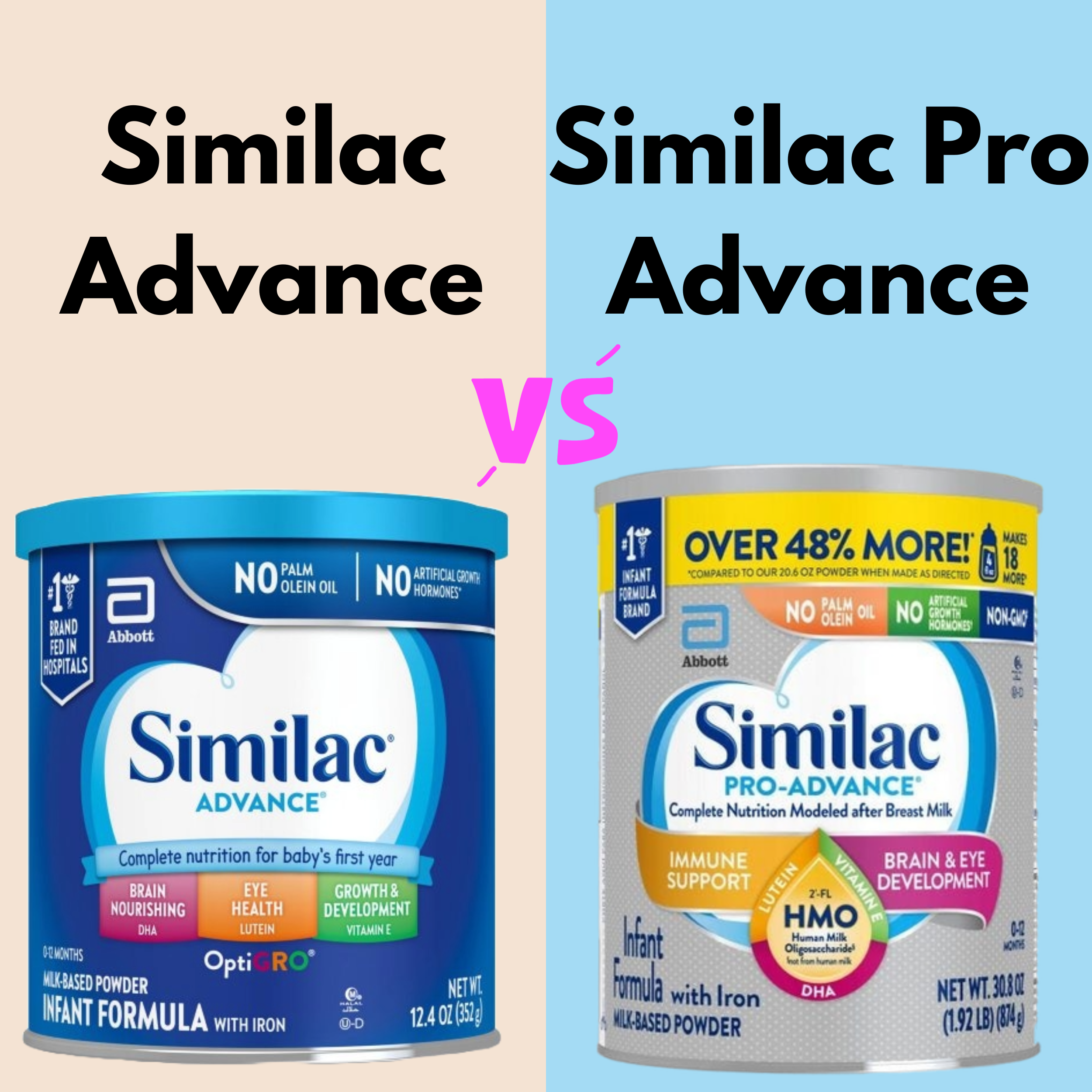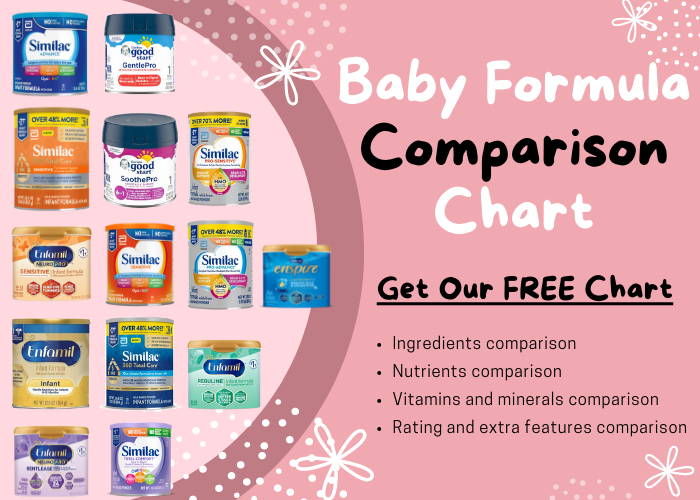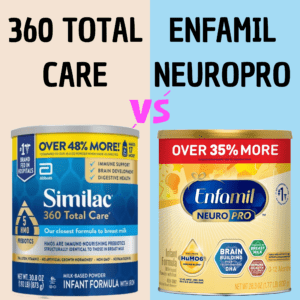Key Differences Between Similac Advance and Pro Advance?
The difference between them is that Similac Advance is an affordable, regular milk-based formula with high carbs whereas Similac Pro-Advance is a non-GMO regular milk-based formula with the new 2′-FL HMO prebiotic for potential digestive benefits.
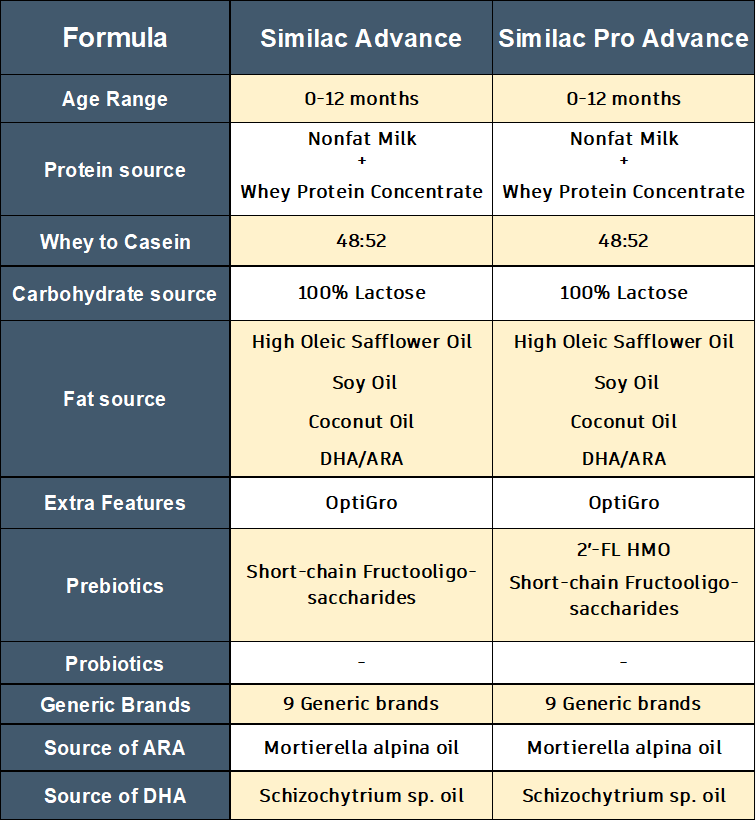
“When you buy something using my links, I may earn a small commission at no additional cost to you. This is a kind of support to me. This website doesn’t accept money for reviews. “
The Best One?
The choice between Similac Advance and Similac Pro-Advance ultimately depends on your specific priorities and your baby’s individual needs. Here are some considerations based on the information provided:
Similac Advance:
- It is more affordable, making it a cost-effective choice.
- It has received high ratings from parents, indicating satisfaction with its performance.
- Many babies find its taste appealing, which can make feeding easier.
Similac Pro-Advance:
- It is a non-GMO formula, which can be an important factor for parents concerned about genetically modified organisms.
- It contains a 2′-FL HMO prebiotic, which can potentially offer benefits for gut health and immunity.
- Some parents report that it may help with weight gain, which can be beneficial for infants who need to catch up on growth.
Both formulas are easy to mix and easy to digest, which are crucial considerations for infant formula. It’s important to note that both Similac Advance and Similac Pro-Advance provide essential nutrition for your baby.
Here’s a summary of potential priorities to help you make a decision:
Choose Similac Advance if:
- Cost is a significant factor for you.
- You trust the high ratings and positive reviews from other parents.
- Your baby enjoys the taste of Similac Advance, which can make feeding smoother.
Choose Similac Pro-Advance if:
- You prefer a non-GMO formula.
- You are interested in the potential benefits of the 2′-FL HMO prebiotic for gut health and immunity.
- Your baby needs additional support for weight gain.
Mom’s Reviews:
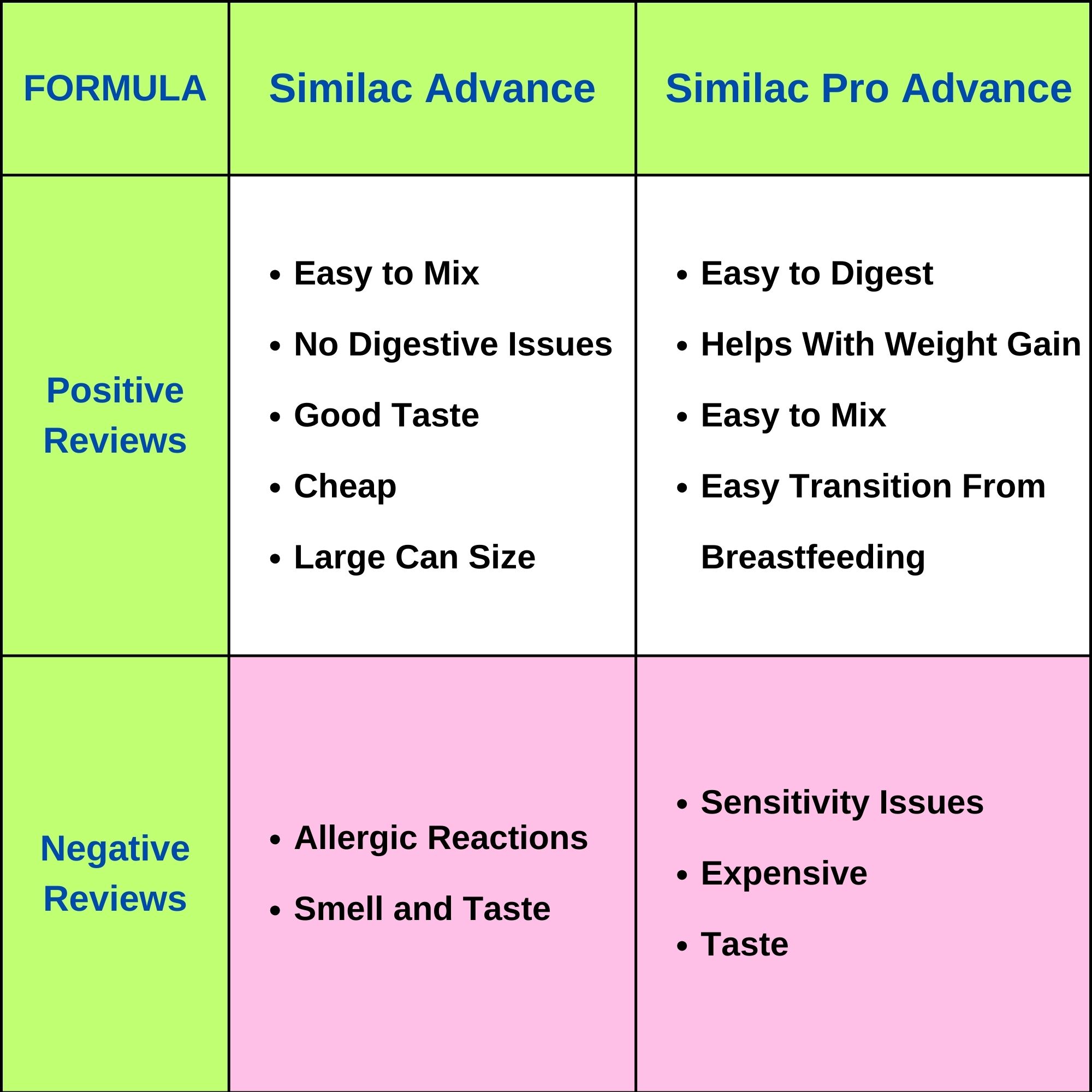
Similac Advance:
Positive Reviews:
Good Quality Formula: Many parents praise the Similac formula for its quality, saying that it meets the nutritional needs of their babies and helps with healthy growth.
No Digestive Issues: Many parents report that their babies have no issues with digesting Similac formula and do not experience discomfort or colic.
Large Can Size: Parents who go through the formula quickly find the large can size convenient, as it lasts longer and reduces the need for frequent purchases.
Negative Reviews:
Allergic Reactions: A few parents report that their babies had allergic reactions and skin issues after using the Similac formula. Every baby is different, and what works for one may not work for another.
Smell and Taste: There are occasional comments about the formula having an undesirable smell or taste. Babies can be sensitive to changes in formula taste, which can lead to refusal.
Similac Pro Advance:
Positive reviews:
Easy to digest: Many parents mentioned that their babies had no issues with digesting Similac Pro-Advance and that it was gentle on their tummies.
Helps with Weight Gain: Parents have noted that their babies thrived on this formula, gained weight appropriately, and received essential nutrients for healthy growth and development.
Easy to mix: Parents appreciated the ease of mixing and preparing Similac Pro-Advance.
Easy Transition from Breastfeeding: Several reviewers mentioned that this formula provided a smooth transition from breastfeeding to formula feeding. Babies had no issues or irritability when switching to this formula.
Related: Similac Advance Vs Enfamil Neuropro
Negative reviews:
Sensitivity Issues: Some parents have reported that their babies experienced sensitivity issues, including gas, reflux, or vomiting while using this formula.
Price: Several users mentioned that Similac Pro-Advance is relatively expensive compared to Similac Advance
Taste Preferences: A few reviewers mentioned that their babies didn’t like the taste of this formula, and transitioning to it was challenging.
Ingredients Comparison:
When comparing Similac Advance and Similac Pro-Advance in terms of their ingredients, we can see several similarities and a key difference:
Protein Source:
- Both Similac Advance and Similac Pro-Advance use a combination of “Nonfat milk + whey protein concentrate” as their primary protein source. This combination is designed to provide a balanced source of essential amino acids for infant growth and development.
Whey to Casein Ratio:
- Both formulas maintain a whey to casein ratio of 48:52, ensuring that infants receive a protein blend that resembles the composition found in breast milk.
Carbohydrate Source:
- Both formulas rely on 100% lactose as the carbohydrate source. Lactose is the natural sugar found in breast milk and is easily digestible by most infants.
Fat Source:
- Both formulas use a blend of “High Oleic Safflower Oil, Soy Oil, and Coconut Oil” as their fat source. These oils provide essential fatty acids necessary for brain and eye development in infants.
Extra Features (OptiGro):
- Both Similac Advance and Similac Pro-Advance include OptiGro, a proprietary blend of ingredients that includes key nutrients such as DHA, lutein, and vitamin E to support brain and eye development, as well as overall growth.
Prebiotics:
- Similac Advance contains “Short-chain Fructooligosaccharides” as its prebiotic component, while Similac Pro-Advance includes “2′-FL HMO + Short-chain Fructooligosaccharides.” The key difference here is the addition of 2′-FL HMO (Human Milk Oligosaccharide) in Similac Pro-Advance. 2′-FL HMO is a prebiotic that is naturally found in breast milk and is believed to have potential benefits for gut health and immune system support in infants.
Probiotics:
- Neither Similac Advance nor Similac Pro-Advance contain added probiotics.
Generic Brands:
- Both formulas have 9 generic brands in case you want cheap and safe alternatives. I made a full article about the Best 9 Generic Similac Advance & Pro Advance Formula if you want to check.
Source of ARA (Arachidonic Acid):
- Both formulas derive ARA from Mortierella alpina oil. ARA is an omega-6 fatty acid important for infant development.
Source of DHA (Docosahexaenoic Acid):
- Both formulas source DHA from Schizochytrium sp. oil, a vegetarian source of omega-3 fatty acids essential for brain and eye development.
In summary, while Similac Advance and Similac Pro-Advance share many common ingredients and nutritional profiles, the key distinguishing factor is the inclusion of 2′-FL HMO in Similac Pro-Advance, which is not present in Similac Advance. This addition is meant to mimic the composition of breast milk more closely and potentially offer additional benefits for gut health and immunity.
Nutrients Comparison:
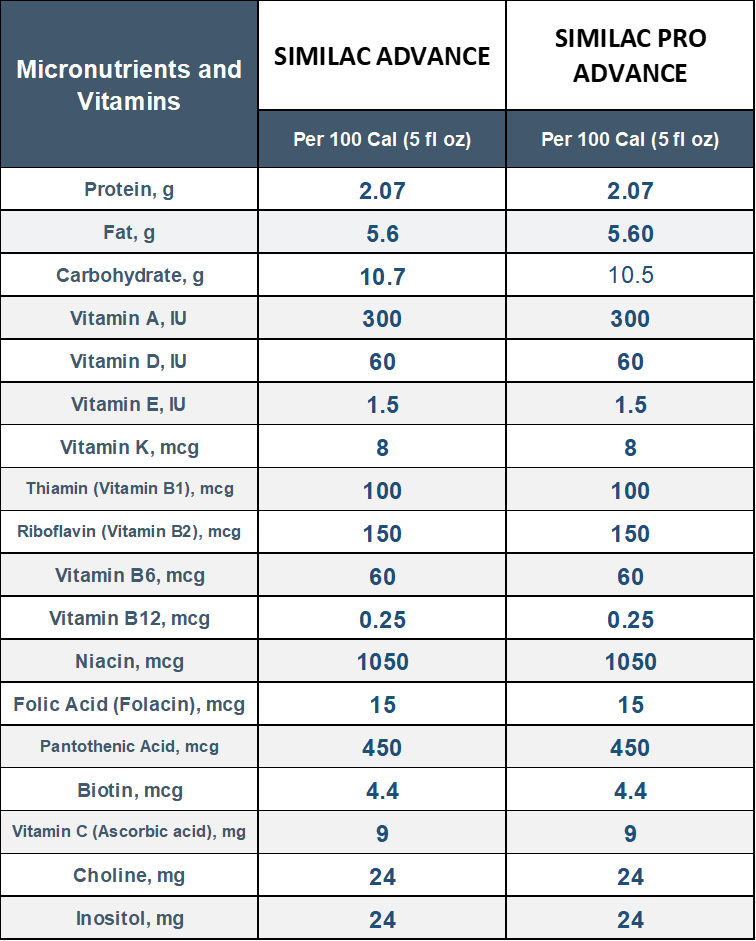
In terms of micronutrients and vitamins, we can observe that both formulas have nearly identical nutrient profiles:
Protein, Fat, and Carbohydrate:
- Both Similac Advance and Pro-Advance provide 2.07 grams of protein per 100 calories. This protein content is essential for a baby’s growth and development.
- Both formulas have 5.6 grams of fat per 100 calories. Fat is crucial for brain development and overall energy supply in infants.
- Similac Advance provides 10.7 grams of carbohydrates per 100 calories, while Pro-Advance contains slightly less, with 10.5 grams per 100 calories. The difference in carbohydrate content is minimal and likely not significant in terms of nutritional impact.
Vitamins:
- Both formulas provide the same amounts of essential vitamins, including vitamin A, vitamin D, vitamin E, vitamin K, thiamin (Vitamin B1), riboflavin (Vitamin B2), vitamin B6, vitamin B12, niacin, folic acid (folacin), pantothenic acid, biotin, vitamin C (ascorbic acid), choline, and inositol. All of these vitamins are crucial for an infant’s overall health, growth, and development.
In summary, when it comes to micronutrients and vitamins, Similac Advance and Pro-Advance have nearly identical nutritional profiles per 100 calories. Both formulas provide essential nutrients required for a baby’s healthy development, and the slight difference in carbohydrate content is unlikely to be of significant concern for most infants.
Minerals:

When comparing Similac Advance and Pro-Advance in terms of minerals, it’s evident that both formulas have identical mineral content, indicating that there are no significant differences between the two in this regard. They are enriched with:
Calcium: Essential for building strong bones and teeth in infants.
Iron: Crucial for oxygen transport in the blood and is essential for preventing iron-deficiency anemia.
Phosphorus: Necessary for bone and cell membrane structure and function
Copper: Essential for the formation of red blood cells and the function of several enzymes.
Price Comparison:
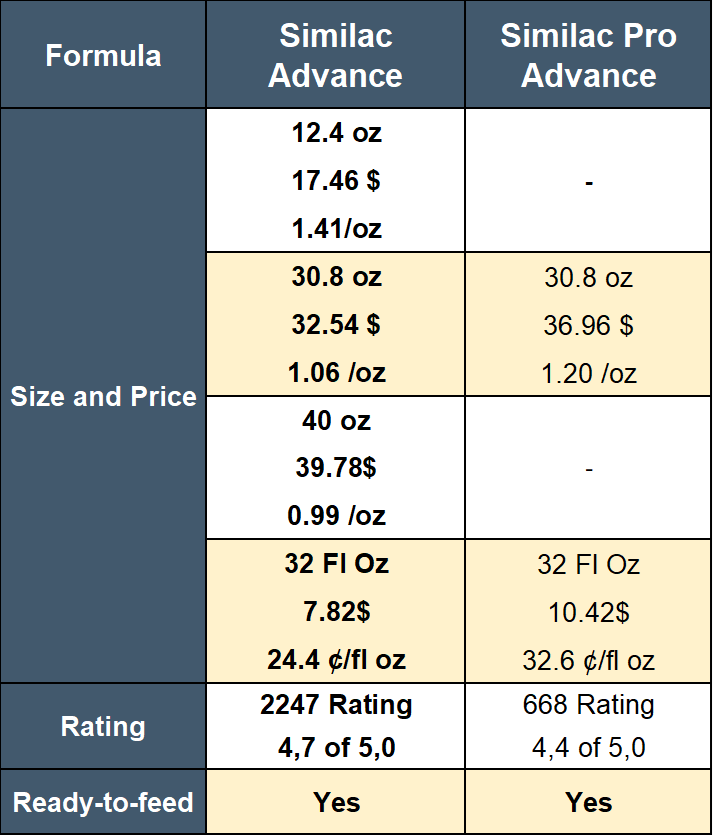
In terms of price, it’s essential to consider the various available sizes and their respective prices. Additionally, customer ratings can provide insight into user satisfaction. Here’s a breakdown of the price and rating comparison:
Similac Advance:
- 12.4 oz container: $17.46, which translates to approximately $1.41 per ounce.
- 30.8 oz container: $32.54, which is approximately $1.06 per ounce.
- 40 oz container: $39.78, approximately $0.99 per ounce.
- 32 Fl Oz ready-to-feed bottle: $7.82, or approximately 24.4 cents per fluid ounce.
- Customer Rating: 4.7 out of 5.0 based on 1,472 ratings.
Similac Pro-Advance:
- 30.8 oz container: $36.96, which is approximately $1.20 per ounce.
- 32 Fl Oz ready-to-feed bottle: $10.42, or approximately 32.6 cents per fluid ounce.
- Customer Rating: 4.5 out of 5.0 based on 780 ratings.
Similac Advance generally tends to be more affordable per ounce in most available sizes compared to Pro-Advance.
In terms of customer ratings, Similac Advance has received a higher rating which means that babies love it more.
Where to Buy?
| SIMILAC ADVANCE | SIMILAC PRO ADVANCE |
|---|---|
Buy 12.4 oz HERE Buy 30.8 oz HERE Buy 40 oz HERE Buy Ready-to-feed | Buy 30.8 oz HERE Buy Ready-to-feed |
The Best Alternative to Similac Advance and Pro Advance:

In case you want to choose an alternative to Similac Advance and Pro Advance, you should see a formula that is regular milk-based with 100% lactose and palm oil-free. Thus, here are some alternatives to these formulas sorted by the best one:
Similac 360 Total Care:
- This formula is designed for infants with sensitive tummies, providing gentle nutrition and easy digestion. It’s a suitable choice if your baby has occasional digestive discomfort thanks to its 5 HMO prebiotics. Read Similac Advance vs. 360 Total Care.
Enfamil Infant:
- Enfamil Infant is a trusted formula that closely resembles breast milk. It offers a balanced mix of nutrients, making it a reliable choice for many babies.
Enfamil NeuroPro:
- Enfamil NeuroPro is fortified with MFGM and DHA, which are important for brain development. If you’re looking for added brain-nourishing ingredients, this may be a good option.
Gerber Good Start Gentle:
- Gerber Good Start Gentle is formulated for babies with sensitive stomachs. It contains probiotics and HMOs for digestive health. Choose it if your baby has digestive sensitivities.
Enfamil Enspire:
- Enfamil Enspire is designed to mimic the composition of breast milk closely. It includes Lactoferrin and MFGM for immune support and brain development, making it suitable for parents seeking premium nutrition.
Organic Alternatives:
- Bobbie, HiPP Combiotic, and Holle Bio are all organic formulas, which can be an excellent choice if you prefer organic ingredients. These formulas may provide a different taste and texture compared to standard milk-based options. Read HiPP Combiotic VS Similac Advance & Pro Advance.
Remember that every baby is unique, and what works well for one may not work for another. Your pediatrician is the best resource for guiding you through the transition and ensuring that your baby’s nutritional needs are met while keeping them comfortable and healthy.
Feel free to ask anything in the comments!!

